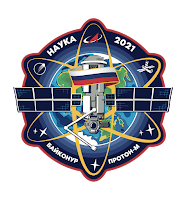ISS - Science Module "Nauka" patch.
July 21, 2021
The European Robotic Arm (ERA) is on its way to the International Space Station after being launched on a Proton rocket from the Baikonur Cosmodrome, in Kazakhstan, at 16:58 CEST today.
ERA's launch
The 11-m-long robot is travelling folded and attached to what will be its home base – the Multipurpose Laboratory Module, also called ‘Nauka’. The Proton-M booster placed Nauka and ERA into orbit around 10 minutes after liftoff, nearly 200 km above Earth.
ERA launch replay
This arm was made for walking
The International Space Station already has two robotic arms; Canadian and Japanese robots play a crucial role in berthing spacecraft and transferring payloads and astronauts. However, neither arm can reach the Russian segment.
ERA is the first robot capable of ‘walking’ around the Russian parts of the orbital complex. It can handle components up to 8000 kg with 5 mm precision, and it will transport astronauts from one working site to another.
ERA in action on the International Space Station
“Moving hand-over-hand around the Russian parts of the Station, the European Robotic Arm will bring more freedom, more flexibility and more skills to space operations,” says ESA Director of Human and Robotic Exploration David Parker.
“We are giving the Space Station a mid-life upgrade after 20 years in orbit through our Columbus 2030 programme – an opportunity to modernise space with a commercial approach,” he adds.
A new arm for space
The launch and installation of the European Robotic Arm is a first for Europe and Russia in space. A consortium of 22 European companies from seven countries built the robot for ESA. The long-awaited premiere of this European-made robot follows 14 years of perseverance.
Arrival to the space home
It will take Nauka eight days to slowly raise its orbit and catch up with the Space Station. On 29 July at 15:26 CEST, the new module will use its engines to dock automatically to Zvezda at the heart of the Russian segment.
ESA astronaut Thomas Pesquet will welcome the robot arm and assist in setting it up. Five spacewalks are planned to get ERA ready and perform its first space operations, some of which will be carried out by ESA astronauts Matthias Maurer and Samantha Cristoforetti.
Samantha Cristoforetti trains with the European Robotic Arm
The crew can control ERA from both inside and outside the Space Station, a feature that no other robotic arm offers.
During its first year on the Space Station, ERA’s prime tasks in orbit are to install a large radiator and set up the airlock for Nauka.
Team effort for the future
Together with the international partners, Europe is preparing to extend the life of the Space Station for years to come.
Where is the European Robotic Arm?
“Our home in space is constantly being improved. Europe’s Columbus lab is getting new science racks, ultra-fast data connections and external and internal platforms, commercially provided, for more users. ESA astronaut Thomas Pesquet has even been helping to upgrade the Station’s power with new solar arrays,” points out David Parker.
The symbolic European-Russian handshake in space will help demonstrate autonomous and real-time telerobotic operations, key for future missions to the Moon and Mars.
Related article:
A European Robotic Arm to handle the Space Station
https://orbiterchspacenews.blogspot.com/2021/07/a-european-robotic-arm-to-handle-space.html
Related links:
European Robotic Arm (ERA): https://www.esa.int/Science_Exploration/Human_and_Robotic_Exploration/International_Space_Station/European_Robotic_Arm
Columbus 2030 programme: https://www.esa.int/Science_Exploration/Human_and_Robotic_Exploration/Call_for_innovation_to_advance_Europe_s_lab_in_space
International Space Station (ISS): https://www.esa.int/Science_Exploration/Human_and_Robotic_Exploration/International_Space_Station
Images, Video, Text, Credits: ESA / ROSCOSMOS / NASA / GCTC.
Best regards, Orbiter.ch





